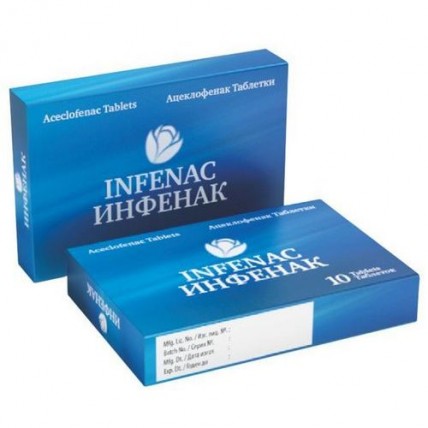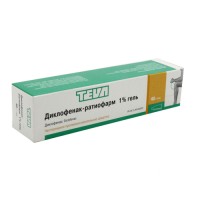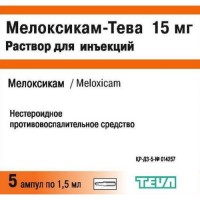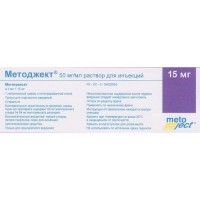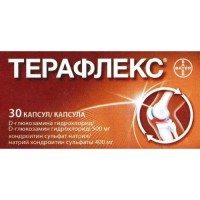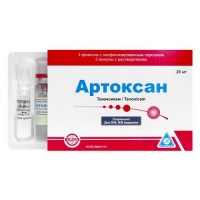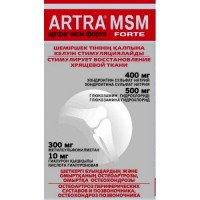Infenak 10s 100 mg film-coated tablets
- $11.50
The instruction for use
of medicine for experts
of INFENAK
the Trade name
Infenak
Mezhdunarodnoye the unlicensed
name Atseklofenak Lekarstvennaya
the Tablet form, film coated, 100 mg
Structure
One tablet contains
active agent – atseklofenak 100 mg,
excipients: microcrystalline cellulose, crosspovidon, hydroxypropyl cellulose, glitserilpalmitostearat, sanset, the atsi-di-salt, water purified magnesium stearate,
structure of a cover: hydroksipropilmetiltsellyuloza, titanium dioxide, talc, isopropyl alcohol, methylene chloride, propylene glycol.
Description
of the Tablet of white color, oval form flat from two parties, film coated
Pharmacotherapeutic group
Anti-inflammatory and antirheumatic drugs. Non-steroidal anti-inflammatory drugs. Derivatives of acetic acid.
ATC M01AB16 code
Pharmacological
Pharmacokinetics Absorption properties: after oral administration atseklofenak it is quickly soaked up, and its biological comprehensibility is nearly 100%. The maximum concentration in blood plasma is reached approximately within 1.25 - 3 hours after intake.
Distribution: atseklofenak actively contacts proteins of blood plasma (99.7%). Atseklofenak gets into synovial fluid where its concentration reaches about 60%. The volume of distribution is about 30 l.
Metabolism and removal: average plasma elimination half-life of blood makes 4-4.3 hours. About two thirds of the accepted dose are removed through urine, mainly, in the form of the conjugated hydroxymetabolites. Only 1% of an oral single dose is removed in steady-state condition. Atseklofenak, most likely, is metabolized through CYP2C9 in the main metabolite of the 4th '-ON-atseklofenak whose influence on clinical activity, most likely, insignificant. The pharmacodynamics
Infenak – a derivative of phenylacetic acid, is new non-steroidal anti-inflammatory drug which has the multiple-factor mechanism of action. Inhibits cyclooxygenase (COG) - the main enzyme of exchange of arachidonic acid, blocks secretion of prostaglandins, suppresses exudative and proliferative phases of inflammation. Restores microcirculation and reduces painful sensitivity in the inflammation center, i.e. possesses expressed anti-inflammatory, analgeziruyushchy and febrifugal actions.
Infenak stimulates synthesis of an extracellular matrix of articulate cartilages (hondroprotektorny action), slows down adhesion and accumulation of neutrophils in the place of inflammation at an early stage and, thus, blocks inflammatory action of neutrophils.
Indications
- inflammatory and degenerative diseases
of the musculoskeletal system
-
the Route of administration and doses ankylosing a spondylarthritis
to Adults and children are more senior than 12 years: 100 mg 2 times a day in time or after meal.
The maximum single dose for adults: 100 mg.
The maximum daily dose for adults: 200 mg.
To accept on demand. If after administration of drug the positive effect is not observed, it is necessary to see a doctor.
Side effects
- diarrhea, an abdominal pain, nausea, dyspepsia
- a headache, dizziness, drowsiness, paresthesias, a tremor,
a sleep disorder
- skin rash, an itching
- it is rare: thrombocytopenia, anemia
- hypostases.
Contraindications
- hypersensitivity to drug components
- aspirinovy triad, aspirinovy asthma
- pregnancy, the lactation period
- children's age up to 12 years
- hemopoiesis disturbances
- a peptic ulcer of a stomach and duodenum.
Medicinal interactions
Are not present pharmacokinetic researches on studying interactions with Infenak except as with warfarin.
Atseklofenak is metabolized by means of P 450 2C9 Cytochrome and can be inhibitor of this enzyme. The risk of pharmacokinetic reactions, therefore, is possible with Phenytoinum, Cimetidinum, tolbutamide, phenylbutazone, Amiodaronum, Miconazolum or sulfafenazoly. Also there is a risk of pharmacokinetic interactions with other drugs removed by active renal secretion with such as methotrexate and lithium. Atseklofenak is connected almost completely with plasma albumine and, therefore, it is possible to assume a possibility of substitution reactions with other drugs which are strongly connected with protein.
Due to insufficiently conducted researches of pharmacokinetic interactions Infenak, the last are based on their study among other NPVS:
The following combinations have to be avoided:
- with a methotrexate as NPVS suppress its tubular secretion, and weak metabolic interaction, with delay of clearance of a methotrexate can take place.
- with lithium as some NPVS suppress its discharge kidneys of which increase in concentration of lithium in blood plasma is result. A combination it is necessary to avoid except for cases with a possibility of frequent measurement of level of lithium in blood.
- with anticoagulants as NPVS suppress aggregation of thrombocytes and damage a mucous cell membrane mucous digestive tract that can lead to increase in activity of anticoagulants and increase risk of appearance of bleedings in the patients receiving anticoagulating drugs. Infenak's combination with oral anticoagulants of group of coumarin, tiklopidiny, trombolitika and heparin it is necessary to avoid, except for cases with need of carrying out careful monitoring.
The following combinations demand regulation of a dose and taking measures of precaution:
Possible interactions between NPVS and a methotrexate can be assumed even when using low doses of a methotrexate, especially at patients with reduced function of kidneys at which increase in plasma level of a methotrexate with manifestation of its toxic properties can be observed.
Purpose of NPVS together with cyclosporine or takrolimusy presumably increases risk of the nephrotoxicity caused by suppression of synthesis of prostacyclin in renal fabric. Therefore, it is necessary to monitor carefully function of kidneys during combination therapy
the care Is required because the accompanying therapy by aspirin or other non-steroidal anti-inflammatory drugs can increase risk of development of side effects.
NPVS can reduce diuretic effect of furosemide, a bimetanid and antihypertensive effect of tiazid. The accompanying therapy potassium - the preserving diuretics can be followed by increase in level of potassium in blood plasma therefore it is necessary to control its plasma level.
NPVS can reduce effect of some antihypertensive medicines. APF inhibitors or antagonists of angiotensin of II receptors in combination with NPVS can lead to deterioration in renal function. The risk of developing of usually reversible acute renal failure can be raised at some patients with disturbances of functions of kidneys, for example, at elderly or in organism dehydration. Therefore, the combination with NPVS has to be appointed with care, with preliminary adequate hydration of the patient and at careful observation of function of kidneys.
It was not defined that Atseklofenak affects the blood pressure when he was appointed with bendroflyuazidy though interaction with other antihypertensive drugs, such as by beta-blockers it cannot be excluded.
Other possible interactions:
There are separate researches about hypoglycemic and hyper glycemic effects of an atseklofenak in this connection it is necessary to be careful at joint appointment of Infenak with anti-diabetic drugs and at patients with disturbances of a glycemic profile.
Special instructions
patients Should appoint with care drug with an abnormal liver function or kidneys and to provide strict observation.
Influence on ability to driving by motor transport and to control of mechanisms.
Patients need to abstain from the activity demanding the increased concentration of attention.
Overdose
Symptoms: headache, dizziness, diarrhea, abdominal pain, nausea, dyspepsia, pressure decline.
Treatment: gastric lavage, symptomatic treatment. There is no specific antidote.
Form of release and packing
of the Tablet, film coated, 100 mg No. 10.
Primary packing: 10 tablets in a strip.
Secondary packing: 1 strip with the instruction for use in cardboard packing.
To Store storage conditions in the dry place at a temperature from + 15 to + 250C.
To protect from moisture and direct sunshine.
To store out of children's reach!
2 years
not to apply a period of storage after an expiration date.
Prescription status
According to the prescription
of Proizvoditel Tulip Lab Prayvat Limited/Tulip of Lab Pvt Limited
the location Address:
215, Anandraj Industrial Estate, Off. L.B.S. Marg, Bhandup (W), Mumbai 400078, India
to Develop
of medicine for experts
of INFENAK
the Trade name
Infenak
Mezhdunarodnoye the unlicensed
name Atseklofenak Lekarstvennaya
the Tablet form, film coated, 100 mg
Structure
One tablet contains
active agent – atseklofenak 100 mg,
excipients: microcrystalline cellulose, crosspovidon, hydroxypropyl cellulose, glitserilpalmitostearat, sanset, the atsi-di-salt, water purified magnesium stearate,
structure of a cover: hydroksipropilmetiltsellyuloza, titanium dioxide, talc, isopropyl alcohol, methylene chloride, propylene glycol.
Description
of the Tablet of white color, oval form flat from two parties, film coated
Pharmacotherapeutic group
Anti-inflammatory and antirheumatic drugs. Non-steroidal anti-inflammatory drugs. Derivatives of acetic acid.
ATC M01AB16 code
Pharmacological
Pharmacokinetics Absorption properties: after oral administration atseklofenak it is quickly soaked up, and its biological comprehensibility is nearly 100%. The maximum concentration in blood plasma is reached approximately within 1.25 - 3 hours after intake.
Distribution: atseklofenak actively contacts proteins of blood plasma (99.7%). Atseklofenak gets into synovial fluid where its concentration reaches about 60%. The volume of distribution is about 30 l.
Metabolism and removal: average plasma elimination half-life of blood makes 4-4.3 hours. About two thirds of the accepted dose are removed through urine, mainly, in the form of the conjugated hydroxymetabolites. Only 1% of an oral single dose is removed in steady-state condition. Atseklofenak, most likely, is metabolized through CYP2C9 in the main metabolite of the 4th '-ON-atseklofenak whose influence on clinical activity, most likely, insignificant. The pharmacodynamics
Infenak – a derivative of phenylacetic acid, is new non-steroidal anti-inflammatory drug which has the multiple-factor mechanism of action. Inhibits cyclooxygenase (COG) - the main enzyme of exchange of arachidonic acid, blocks secretion of prostaglandins, suppresses exudative and proliferative phases of inflammation. Restores microcirculation and reduces painful sensitivity in the inflammation center, i.e. possesses expressed anti-inflammatory, analgeziruyushchy and febrifugal actions.
Infenak stimulates synthesis of an extracellular matrix of articulate cartilages (hondroprotektorny action), slows down adhesion and accumulation of neutrophils in the place of inflammation at an early stage and, thus, blocks inflammatory action of neutrophils.
Indications
- inflammatory and degenerative diseases
of the musculoskeletal system
-
the Route of administration and doses ankylosing a spondylarthritis
to Adults and children are more senior than 12 years: 100 mg 2 times a day in time or after meal.
The maximum single dose for adults: 100 mg.
The maximum daily dose for adults: 200 mg.
To accept on demand. If after administration of drug the positive effect is not observed, it is necessary to see a doctor.
Side effects
- diarrhea, an abdominal pain, nausea, dyspepsia
- a headache, dizziness, drowsiness, paresthesias, a tremor,
a sleep disorder
- skin rash, an itching
- it is rare: thrombocytopenia, anemia
- hypostases.
Contraindications
- hypersensitivity to drug components
- aspirinovy triad, aspirinovy asthma
- pregnancy, the lactation period
- children's age up to 12 years
- hemopoiesis disturbances
- a peptic ulcer of a stomach and duodenum.
Medicinal interactions
Are not present pharmacokinetic researches on studying interactions with Infenak except as with warfarin.
Atseklofenak is metabolized by means of P 450 2C9 Cytochrome and can be inhibitor of this enzyme. The risk of pharmacokinetic reactions, therefore, is possible with Phenytoinum, Cimetidinum, tolbutamide, phenylbutazone, Amiodaronum, Miconazolum or sulfafenazoly. Also there is a risk of pharmacokinetic interactions with other drugs removed by active renal secretion with such as methotrexate and lithium. Atseklofenak is connected almost completely with plasma albumine and, therefore, it is possible to assume a possibility of substitution reactions with other drugs which are strongly connected with protein.
Due to insufficiently conducted researches of pharmacokinetic interactions Infenak, the last are based on their study among other NPVS:
The following combinations have to be avoided:
- with a methotrexate as NPVS suppress its tubular secretion, and weak metabolic interaction, with delay of clearance of a methotrexate can take place.
- with lithium as some NPVS suppress its discharge kidneys of which increase in concentration of lithium in blood plasma is result. A combination it is necessary to avoid except for cases with a possibility of frequent measurement of level of lithium in blood.
- with anticoagulants as NPVS suppress aggregation of thrombocytes and damage a mucous cell membrane mucous digestive tract that can lead to increase in activity of anticoagulants and increase risk of appearance of bleedings in the patients receiving anticoagulating drugs. Infenak's combination with oral anticoagulants of group of coumarin, tiklopidiny, trombolitika and heparin it is necessary to avoid, except for cases with need of carrying out careful monitoring.
The following combinations demand regulation of a dose and taking measures of precaution:
Possible interactions between NPVS and a methotrexate can be assumed even when using low doses of a methotrexate, especially at patients with reduced function of kidneys at which increase in plasma level of a methotrexate with manifestation of its toxic properties can be observed.
Purpose of NPVS together with cyclosporine or takrolimusy presumably increases risk of the nephrotoxicity caused by suppression of synthesis of prostacyclin in renal fabric. Therefore, it is necessary to monitor carefully function of kidneys during combination therapy
the care Is required because the accompanying therapy by aspirin or other non-steroidal anti-inflammatory drugs can increase risk of development of side effects.
NPVS can reduce diuretic effect of furosemide, a bimetanid and antihypertensive effect of tiazid. The accompanying therapy potassium - the preserving diuretics can be followed by increase in level of potassium in blood plasma therefore it is necessary to control its plasma level.
NPVS can reduce effect of some antihypertensive medicines. APF inhibitors or antagonists of angiotensin of II receptors in combination with NPVS can lead to deterioration in renal function. The risk of developing of usually reversible acute renal failure can be raised at some patients with disturbances of functions of kidneys, for example, at elderly or in organism dehydration. Therefore, the combination with NPVS has to be appointed with care, with preliminary adequate hydration of the patient and at careful observation of function of kidneys.
It was not defined that Atseklofenak affects the blood pressure when he was appointed with bendroflyuazidy though interaction with other antihypertensive drugs, such as by beta-blockers it cannot be excluded.
Other possible interactions:
There are separate researches about hypoglycemic and hyper glycemic effects of an atseklofenak in this connection it is necessary to be careful at joint appointment of Infenak with anti-diabetic drugs and at patients with disturbances of a glycemic profile.
Special instructions
patients Should appoint with care drug with an abnormal liver function or kidneys and to provide strict observation.
Influence on ability to driving by motor transport and to control of mechanisms.
Patients need to abstain from the activity demanding the increased concentration of attention.
Overdose
Symptoms: headache, dizziness, diarrhea, abdominal pain, nausea, dyspepsia, pressure decline.
Treatment: gastric lavage, symptomatic treatment. There is no specific antidote.
Form of release and packing
of the Tablet, film coated, 100 mg No. 10.
Primary packing: 10 tablets in a strip.
Secondary packing: 1 strip with the instruction for use in cardboard packing.
To Store storage conditions in the dry place at a temperature from + 15 to + 250C.
To protect from moisture and direct sunshine.
To store out of children's reach!
2 years
not to apply a period of storage after an expiration date.
Prescription status
According to the prescription
of Proizvoditel Tulip Lab Prayvat Limited/Tulip of Lab Pvt Limited
the location Address:
215, Anandraj Industrial Estate, Off. L.B.S. Marg, Bhandup (W), Mumbai 400078, India
to Develop
